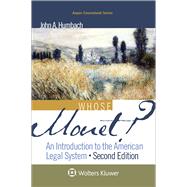The author and his colleagues have used these materials successfully in their classrooms for many years, ensuring their teachability and effectiveness:
- Whose Monet? can be used as primary course material in orientation courses or seminars, as well as collateral reading for in-semester Legal Process or Civil Procedure courses
- The organization is logical and straightforward and the accessible writing style--lucid, descriptive, and conversational--is ideal for incoming students
- The major events in a lawsuit are considered, and the text sheds light on how the law is applied in a civil dispute, introducing common law and statutory law and the various courts and their interrelationship (trial/appellate, state/federal)
- The author draws on judicial opinions, litigation papers, transcripts, and selections from commentators and various jurisprudential sources, thereby exposing the first-year student to as broad a spectrum of materials as possible
- Telling the story of a real lawsuit (DeWeerth v. Baldinger)--from client intake through trial and various appeals--draws students into the legal process by means of an engaging narrative and makes for a truly enjoying teaching experience for professors
- The lawyer's role is examined in both its functional and moral dimensions: What do lawyers do? What does society legitimately expect lawyers to do?
- This book is suitable for both classroom and stand-alone assigned reading









